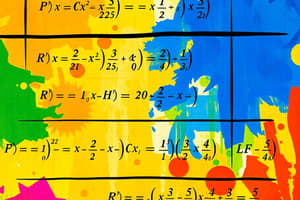Podcast
Questions and Answers
Türev, bir fonksiyonun hangi özelliğini ölçer?
Türev, bir fonksiyonun hangi özelliğini ölçer?
- Fonksiyonun minimum noktasını
- Fonksiyonunintegralini
- Fonksiyonun maksimum noktasını
- Fonksiyonun değeri nasıl değiştiğini (correct)
Fonksiyonun türevi, hangi noktalarda bulunur?
Fonksiyonun türevi, hangi noktalarda bulunur?
- Fonksiyonun her hangi bir noktasında (correct)
- Fonksiyonun hiçbir noktasında
- Fonksiyonun maksimum noktalarında
- Fonksiyonun minimum noktalarında
Üçüncü kural hangi hüküm ile ilgilidir?
Üçüncü kural hangi hüküm ile ilgilidir?
- Zincir kuralı
- Pay kuralı (correct)
- Üs kuralı
- Çarpım kuralı
Türevin geometrik yorumu nedir?
Türevin geometrik yorumu nedir?
İkinci türev, hangi özellik ile ilgilidir?
İkinci türev, hangi özellik ile ilgilidir?
Türev, hangi işlem ile bulunur?
Türev, hangi işlem ile bulunur?
Çarpım kuralı, hangi durumda kullanılır?
Çarpım kuralı, hangi durumda kullanılır?
Türevin pozitif olması, hangi durum için karakteristiktir?
Türevin pozitif olması, hangi durum için karakteristiktir?
Flashcards are hidden until you start studying
Study Notes
Introduction to Derivatives
- A derivative measures how a function changes as its input changes.
- It is a fundamental concept in calculus, used to study rates of change and slopes of curves.
Notation and Terminology
- The derivative of a function f(x) is denoted as f'(x) or (d/dx)f(x).
- The process of finding a derivative is called differentiation.
- The derivative of a function at a point represents the rate of change of the function at that point.
Rules of Differentiation
- Power Rule: If f(x) = x^n, then f'(x) = nx^(n-1).
- Product Rule: If f(x) = u(x)v(x), then f'(x) = u'(x)v(x) + u(x)v'(x).
- Quotient Rule: If f(x) = u(x)/v(x), then f'(x) = (u'(x)v(x) - u(x)v'(x)) / v(x)^2.
- Chain Rule: If f(x) = g(h(x)), then f'(x) = g'(h(x)) * h'(x).
Geometric Interpretation
- The derivative of a function at a point represents the slope of the tangent line to the function at that point.
- A positive derivative indicates an increasing function, a negative derivative indicates a decreasing function, and a zero derivative indicates a horizontal tangent.
Higher-Order Derivatives
- The second derivative, denoted as f''(x), represents the rate of change of the first derivative.
- Higher-order derivatives can be used to analyze the concavity and inflection points of a function.
Türevlere Giriş
- Bir funciónun girdi değeri değiştikçe nasıl değiştiğini ölçer.
- Kalkülüsün temel kavramlarından biri olarak, oran değişim hızını ve eğri eğimlerini incelemek için kullanılır.
Notasyon ve Terminoloji
- Bir función f(x) 'nin türevi, f'(x) veya (d/dx)f(x) olarak gösterilir.
- Bir türev bulma işlemi diferansiyelendirme olarak adlandırılır.
- Bir noktadaki bir funciónun türevi, o noktadaki funciónun değişim hızını temsil eder.
Diferansiyelendirme Kuralları
- Güç Kuralı: Eğer f(x) = x^n ise, o zaman f'(x) = nx^(n-1).
- Ürün Kuralı: Eğer f(x) = u(x)v(x) ise, o zaman f'(x) = u'(x)v(x) + u(x)v'(x).
- Oran Kuralı: Eğer f(x) = u(x)/v(x) ise, o zaman f'(x) = (u'(x)v(x) - u(x)v'(x)) / v(x)^2.
- Zincir Kuralı: Eğer f(x) = g(h(x)) ise, o zaman f'(x) = g'(h(x)) * h'(x).
Geometrik Yorum
- Bir noktadaki bir funciónun türevi, o noktadaki funciónun teğet çizgisinin eğimini temsil eder.
- Pozitif bir türev, artan bir funciónu gösterir, Negatif bir türev, azalan bir funciónu gösterir, ve sıfır türev, yatay bir teğet çizgisini gösterir.
Yüksek Düzeyli Türevler
- İkinci türev, f''(x) olarak gösterilir, ve birinci türevin değişim hızını temsil eder.
- Yüksek düzeyli türevler, bir funciónun konkavitesi ve dönüm noktalarını analiz etmek için kullanılır.
Studying That Suits You
Use AI to generate personalized quizzes and flashcards to suit your learning preferences.




